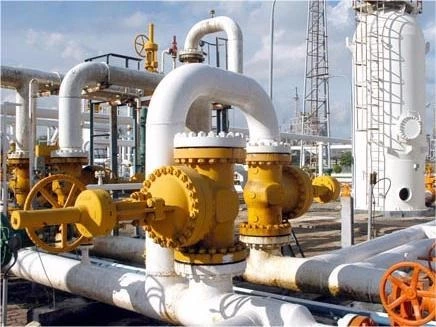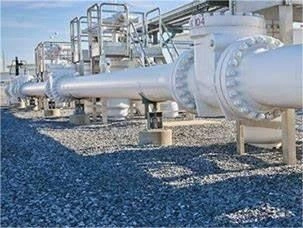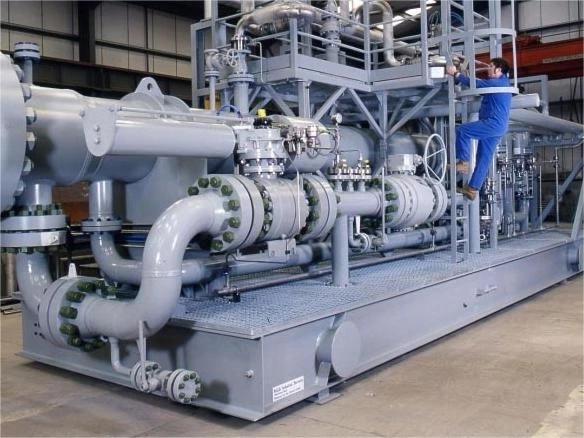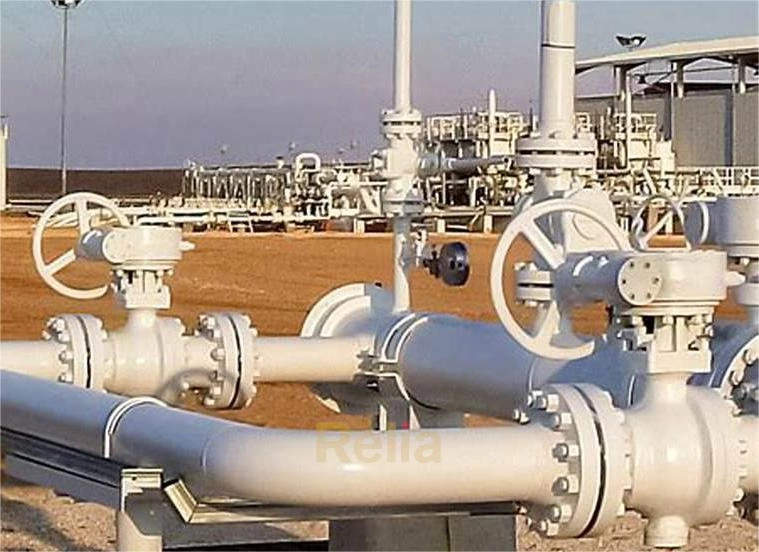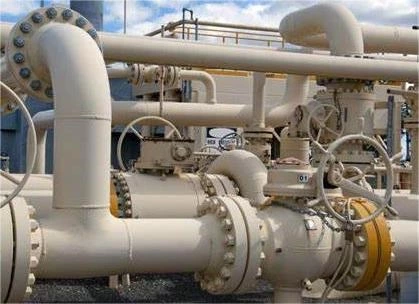Ball Valve
Ball valves are a species of plug valves having a ball-shaped closure member. The seat matching the ball is circular so that the seating stress is circumferentially uniform. Most ball valves are also equipped with soft seats that conform readily to the surface of the ball. Thus, from the point of sealing, the concept of the ball valve is excellent. The valves shown in Figure 3-60 through Figure 3-66 are typical of the ball valves available.
The flow-control characteristic that arises from a round port moving across a circular seat and from the double pressure drop across the two seats is very good. However, if the valve is left partially open for an extended period under conditions of a high pressure drop across the ball, the soft seat will tend to flow around the edge of the ball orifice and possibly lock the ball in that position. Ball valves for manual control are therefore best suited for stopping and starting flow and moderate throttling. If flow control is automatic, the ball is continuously on the move, thus keeping this failure from normally occurring.
Because the ball moves across the seats with a wiping motion, ball valves will handle fluids with solids in suspension. However, abrasive solids will damage the seats and the ball surface. Long, tough fibrous material may also present a problem, as the fiberstend to wrap around the ball.
To economize in the valve construction, most ball valves have a reduced bore with a venturi-shaped flow passage of about three-quarters the nominal valve size. The pressure drop across the reduced-bore ball valve is thereby so small that the cost of a full-bore ball valve is not normally justified. However, there are applications when a full-bore ball valve is required, as for example, when the pipeline has to be scraped.
Seat Materials for Ball Valves
The most important seat material for ball valves is PTFE, which is inert to almost all chemicals. This property is combined with a low coefficient of friction, a wide range of temperature application, and excellent sealing properties. However, the physical properties of PTFE include also a high coefficient of expansion, susceptibility to cold flow, and poor heat trans- fer. The seat must therefore be designed around these properties. Plastic materials for ball valve seats also include filled PTFE, nylon, and many others. However, as the seating material becomes harder, the sealing reli- ability tends to suffer, particularly at low-pressure differentials. Elastomers such as buna-N are also used for the seats, but they impose restrictions on fluid compatibility and range of temperature application. In addition, elastomers tend to grip the ball, unless the fluid has sufficient lubricity. For services unsuitable for soft seatings, metal and ceramic seatings are being used.
Seating Designs
The intimate contact between the seatings of ball valves maybe achieved in a number of ways. Some of the ones more frequently used are:
- By the fluid pressure forcing a floating ball against the seat, as in the valves shown in Figure 3-60 through Figure 3-63.
- By the fluid pressure forcing a floating seat ring against a trunnion- supported ball, as in the valve shown in Figure 3-64.
- By relying mainly on the installed prestress between the seats and a trunnion-supported ball, as in the valve shown in Figure 3-65.
- By means of a mechanical force, which is introduced to the ball and seat on closing, as in the valve shown in Figure 3-66.
Ball valves are also available in which the seal between the seat and ball is achieved by means of a squeeze ring such as an O-ring.
The first sealing method, in which the seating load is regulated by the fluid pressure acting on the ball, is the most common one. The permissible operating pressure is limited in this case by the ability of the downstream seat ring to withstand the fluid loading at the operating temperature without permanent gross deformation.
The seat rings of the valves shown in Figure 3-60 and Figure 3-61 are provided with a cantilevered lip, which is designed so that the ball contacts initially only the tip of the lip. As the upstream and downstream seats are pre-stressed on assembly against the ball, the lips deflect and put the seat rings into torsion. When the valve is being closed against the line pressure, the lip of the downstream seat deflects still further until finally the entire seat surface matches the ball. By this design, the seats have some spring action that promotes good sealing action also at low fluid pressures. Furthermore, the resilient construction keeps the seats from being crushed at high fluid loads.
The seat rings of the valve shown in Figure 3-60 are provided with peripheralslots, which are known as pressure-equalizing slots. These slots reduce the effect of the upstream pressure on the total valve torque. This is achieved by letting the upstream pressure filter by the upstream seat ring into the valve body cavity so that the upstream seat ring becomes pressure balanced.
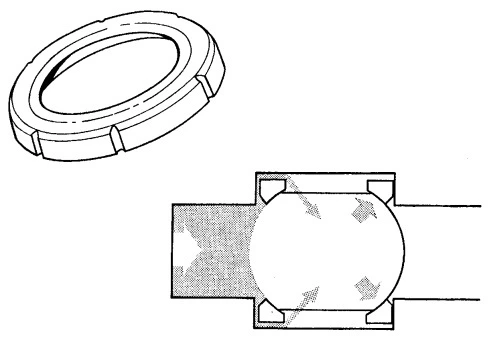
Figure 3-60. Schematic View of Ball Valve with Floating Ball and Torsion Seats, Showing Function of Pressure-Equalizing Slots in Periphery of Seats.

Figure 3-61. Ball Valve with Floating Ball and Torsion Seats, with Axial-Entry Body.
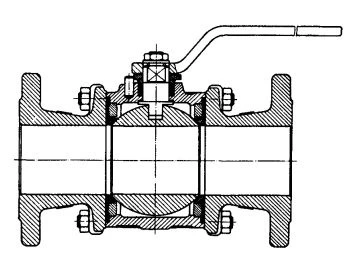
Figure 3-62. Ball Valve with Floating Ball and Diaphragm-Supported Seats, with Sandwich-Split Body.
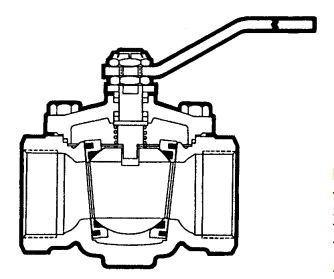
Figure 3-63. Ball Valve with Wedge Seats Spring-Loaded from the Top, with One-Piece Top-Entry Body.
The valves shown in Figure 3-62 and Figure 3-63 are also designed to ensure a preload between the seatings. This is achieved in the valve shown in Figure 3-62 by supporting the seat rings on metal diaphragms that act as springs on the back of the seat rings. The seating preload of the valve shown in Figure 3-63 is maintained by a spring that forces the ball and seat-ring assembly from the top into wedge-shaped seat ring back faces in the valve body.
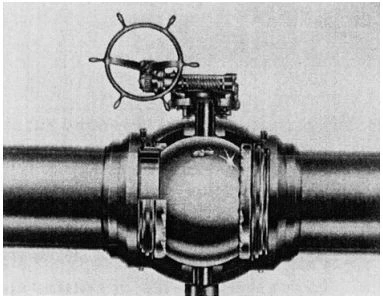
Figure 3-64. Ball Valve with Trunnion-Supported Ball and Floating Seats, with One-Piece Sealed Body.
The design of the ball valve shown in Figure 3-64 is based on the second seating method in which the fluid pressure forces the seat ring against a trunnion-supported ball. The floating seat ring is sealed thereby peripher- ally by an O-ring. Because the pressure-uncompensated area of the seat ring can be kept small, the seating load for a given pressure rating can be regulated to suit the bearing capacity of the seat. These valves may therefore be used for high fluid pressures outside the range of floating-ball type ball valves. This particular valve also has a device that rotates the seat rings by a small amount each time the valve is operated. The purpose of this rotating action is to evenly distribute the seat wear. Should the seat seal fail, a temporary seat seal can be provided by the injection of a sealant to the seatings.
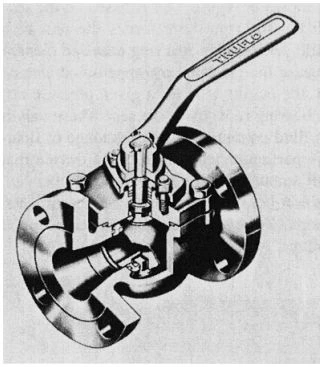
Figure 3-65. Ball Valve with Trunnion-Supported Ball and Wedge Seats Forced into the Valve Body by the Bonnet, with One-Piece Top-Entry Body.
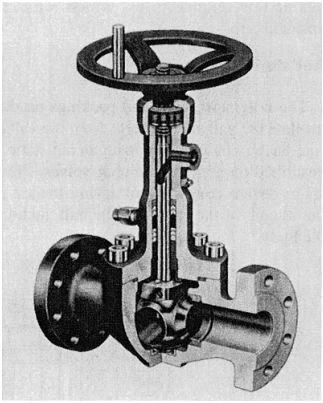
Figure 3-66. Ball Valve with Cam Mechanism to Seat and Unseat Ball.
The third seating method in which the seat seal depends mainly on the installed prestress between the seats and a trunnion-supported ball, as in the valve shown in Figure 3-65, is designed to limit the operating torque of the valve at high fluid pressures. The lips around the ports of the ball are radiused (rounded) to reduce the seating interference when the ball is in the open position. When the ball is moved into the closed position, the seating interference increases. If the valve is required for double block and bleed, the back of the seat rings must be provided with an elastomeric O-ring.
The fourth seating method in which the seating load is regulated on closing by an introduced mechanical force is designed to avoid most of the sliding action between the seatings. In the valve shown in Figure 3-66, this is achieved by a cam mechanism that lifts the ball out of the seat prior to opening the valve and forces the ball back into the seat after closing the valve.
Pressure-Equalizing Connection
Double-seated ball valves may contain a sealed valve body cavity in both the open and closed valve positions. When the valve is closed, the sealed cavity extends between the upstream and downstream seats. When the valve is open, a sealed cavity may exist also between the ball and the valve body. If these cavities are filled with a liquid of high thermal expansion, the pressure rise in these cavities may overstress some valve components because of thermal expansion of the trapped fluid, unless the excess fluid pressure can be relieved.
The cavity between the ball and the valve body is normally relieved to the flow passage via a hole in the top or bottom flank of the ball. If the valve is closed, the excess pressure in the cavity between the seats may be relieved in various ways.
In the case of ball valves with floating seats, as shown in Figure 3-64, excess pressure in the valve body will open the upstream seat seal where the least pressure differential exists. This permits the excess pressure to escape.
In other double-seated ball valves, however, the fluid pressure must overcome the prestress between the ball and the upstream seat. If the seat rings are provided with some springing action, as in the valves shown in Figure 3-60 through Figure 3-62, the fluid pressure may be able to open the upstream seat seal without becoming excessively high. On the other hand, if the seat rings are of a more rigid construction, thermal expansion of the trapped fluid may create an excessively high pressure in the sealed cavity, depending on the prestress between the upstream seatings. In this case, the upstream flank of the ball is usually provided with a pressure-equalizing hole, thus permitting flow through the valve in one direction only. If the valve catalog does not advise on the need for pressure-equalizing connection, the manufacturer should be consulted. The provision of a pressure-equalizing connection is not normally standard with ball valves except for cryogenic service. The pressure-equalizing connec- tion is necessary in that case because of the rigidity of normally soft plastics at low temperatures, which tends to resist the opening of the upstream seat seal.
Antistatic Device
The polymeric seats and packings used in ball valves can electrically insulate the ball and the stem from the valve body. Ball valves may there- fore have to be provided with an antistatic device for the same reason as described on page 98 for plug valves. Figure 3-67 shows a typical anti- static device consisting of spring-loaded plungers—one fitted between the tongue of the stem and the ball, and a second between the stem and the body.
Ball Valves for Fire Exposure
The soft seals for seat and stem commonly used in ball valves will dis- integrate if the valve is exposed to fire for a long enough period. If such valves are used for flammable fluids, they must be designed so that loss of the soft seals due to an external fire does not resultin gross internal and external valve leakage. Such designs provide emergency seals for seat and stem that come into operation after the primary seals have failed.
The emergency seat seal maybe provided by a sharp-edged or chamfered secondary metal seat in close proximity to the ball, so that the ball can float against the metal seat after the soft seating rings have disintegrated.
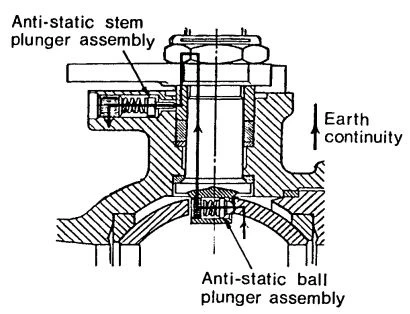
Figure 3-67. Antistatic Device for Grounding Stem to Ball and Stem to Body.
The stuffing box may be fitted with an auxiliary asbestos-based or pure graphite packing, or the packing may be made entirely of an asbestos compound or pure graphite.
Numerous standards have been established that cover the requirements for testing and evaluating the performance of soft-seated ball valves when exposed to fire. The three basic standards are BS 5146, API 607, and API RP 6F.
BS 5146 is a derivative of OCMAFA VI, which itself was taken from a test specification created by Esso Petroleum in the U.K. This test differed from all former ones by requiring the valve to be in the open position during the test and by using a flammable liquid in the valve. The test owes its origin to the recognition by Esso that, in an actual plant fire, a significant number of valves may be in the open position and must be subsequently closed. Moves are underfoot by a number of standard organizations to arrive at an international fire-test specification.
Besides paying attention to the fire testing of ball valves in systems handling flammable fluids, similar attention must be paid to the effect of fire on the entire fluid handling system including valves other than ball valves, valve operators, pumps, filters, pressure vessels, and, not least, the pipe flanges, bolting, and gaskets.
Fire-tested ball valves are referred to as fire-safe. However, this term is unacceptable to valve manufacturers from the product liability standpoint.
Multiport Configuration
Ball valves adapt to multiport configurations in a manner similar to plug valves, previously discussed on page 98.
Ball Valves for Cryogenic Service
Ball valves are used extensively in cryogenic services, but their design must be adapted for this duty. A main consideration in the design of these valves is the coefficient of thermal contraction of the seat ring material, which is normally higher than that of the stainless steel of the ball and valve body. The seat rings shrink, therefore, on the ball at low temperatures and cause the operating torque to increase. In severe cases, the seat ring may be overstressed, causing it to split.
This effect of differential thermal contraction between the seats and the ball maybe combated by reducing the installed prestress between the seats and the ball by an amount that ensures a correct prestress at the cryogenic operating temperature. However, the sealing capacity of these valves may not be satisfactory at low fluid pressures if these valves also have to operate at ambient temperatures.
Other means of combating the effect of differential thermal contraction between the seats and the ball include supporting the seats on flexible metal diaphragms; choosing a seat-ring material that has a considerably lower coefficient of contraction than virgin PTFE, such as graphite or carbon filled PTFE; or making the seat rings of stainless steel with PTFE inserts in which the PTFE contents are kept to a minimum.
Because plastic seat-ring materials become rigid at cryogenic tempera- tures, the surface finish of the seatings and the sphericity of the ball must be of a high standard to ensure a high degree of seat tightness. Also, as with other types of valves for cryogenic service, the extended bonnet should be positioned no more than 45。 from the upright to ensure an effective stem seal.
Variations of Body Construction
Access to the ball valve internals can be provided in various ways. This has led to the development of a number of variations in the body construction; Figure 3-68 shows the most common variations.
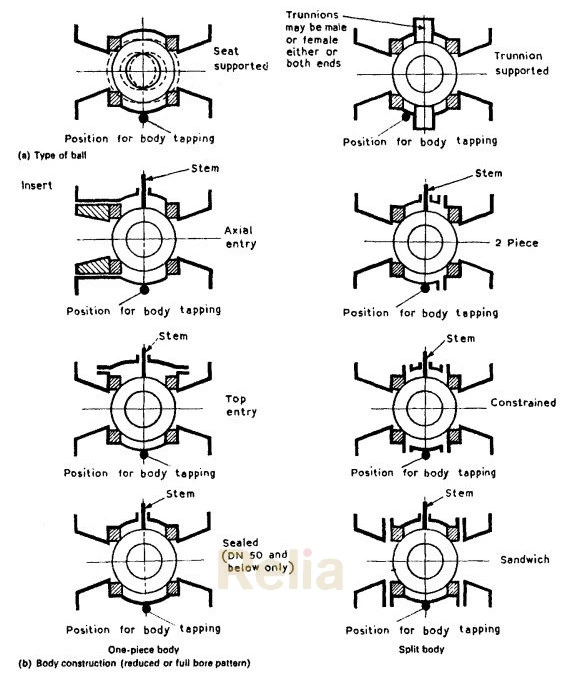
Figure 3-68. Different Types of Body Construction and Body Tapping Locations.
The one-piece body has the fewest number of body joints subject to pipeline stresses. This type of body therefore is often chosen for hazardous fluids. If the valve is to be buried, the sealed-body variety is frequently used. The one-piece body with top entry and the various split body constructions offer easy entry to the valve internals. In the case of welded-in-line valves, those with top entry may also be serviced in< < situ< . A selection from these types is often a matter of personal preference.
Face-to-Face Dimensions
The original practice of U.S. manufacturers was to make the face-to-face dimensions of flanged ball valves to the nearest valve standard, which gave minimum material content. This happened to be the gate valve standard, but the face-to-face dimensions of class 150 and of sizes DN 200 (NPS 8) through DN 300 (NPS 12) of class 300 permitted only reduced-bore construction.
In 1961, when UK manufacturers also introduced the flanged ball valve, there was an additional demand for full-bore ball valves. When it was impossible to accommodate the full-bore ball valve in the confines of the face-to-face dimensions of gate valves, the face-to-face dimensions of regular-pattern plug valves were adopted.
Thus, there is a short and a long series of ball valves for class 150, and in sizes DN 200 (NPS 8) through DN 300 (NPS 12), and for class 300—one for reduced-bore and one for full-bore ball valves, respectively. In the case of the higher-pressure ratings, the face-to-face dimensions of gate valves accommodate both reduced-bore and full-bore ball valves throughout.
The master standard for face-to-face dimensions is ISO 5752. This standard includes all the recognized dimensions worldwide that are used in the piping industry. However, ISO 5752 does not try to define reduced- bore or full-bore except for sizes DN 200 (NPS 8) through DN 300 (NPS 12) of class 300.
Standards Pertaining to Ball Valves
Appendix C provides a list of U.S. and British standards pertaining to ball valves.
Applications
Duty:
- Stopping and starting flow
- Moderate throttling
- Flow diversion
Service:
- Gases
- Liquids
Non-abrasive slurries
- Vacuum
- Cryogenic
